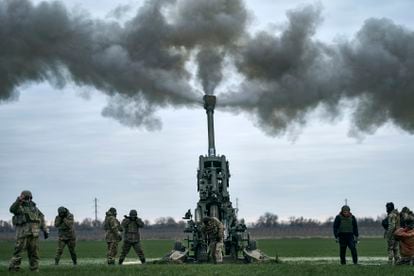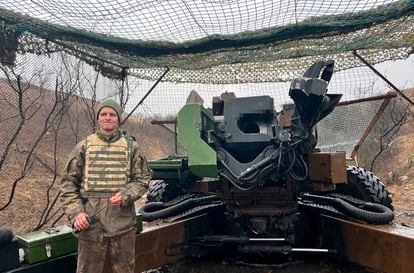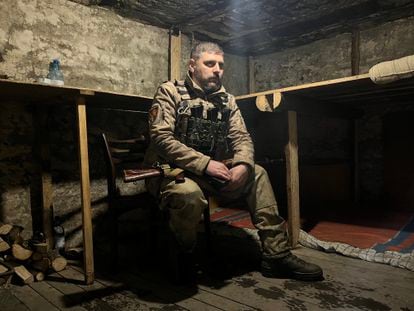MARÍA R. SAHUQUILLO

The Ukraine war has become a ferocious battle dominated by artillery and Ukrainian forces are operating at a huge disadvantage: Russia has numerical superiority of 10 heavy guns to every one at the disposal of Kyiv. Furthermore, Ukraine is running low on ammunition and requires urgent supplies of shells, Volodymyr Zelenskiy’s government has warned.
On the Luhansk front, at one of the Ukrainian army’s advanced positions in the area around the occupied city of Kreminna where the fighting is particularly intense, an artillery brigade is busy tuning a TRF1 howitzer cannon installed amid their sodden trenches. They received the French 155mm gun a few months ago and it is proving key to repelling Russian troops. But as the war enters its second year, Kyiv is in desperate need of fresh materiel. “We need more; we need all the ammunition they can provide. And we need it now,” says Sergey, the brigade commander, anchored next to the cannon in the mud.
The skies above are heavy with clouds and rain, making it difficult for Russian bombers and surveillance drones to operate. In the distance, a few stray explosions can be heard in the rolling hills of the Donbas. According to data from the European Commission to which EL PAÍS has had access, Russia fires between 40,000 and 50,000 artillery shells per day, compared to 5,000-6,000 Ukrainian forces expend. The Estonian government, which has been one of largest contributors to Kyiv’s war effort, puts the average use of artillery at between 20,000 and 60,000 Russian shells per day, and 2,000 to 7,000 Ukrainian rounds, according to a document sent to EU Member States by Tallinn, to which this newspaper has had access. These numbers equate to between 600,000 and 1.8 million Russian shells fired per month, compared to between 60,000 and 210,000 by Ukrainian artillery.
 A Ukrainian soldier, next to a French Howitzer TRFI cannon.MARÍA SAHUQUILLO
A Ukrainian soldier, next to a French Howitzer TRFI cannon.MARÍA SAHUQUILLOThe battle for Bakhmut
The situation is particularly complicated in Donbas, where the artillery battle is at its most intense. The war has become entrenched in the mining region, where pro-Russian separatists backed by the Kremlin and Ukrainian forces have been engaged in fighting since 2014. The battle for Bakhmut, where the opposing sides are locked in a vicious and grueling contest for control of the city, is become “more and more difficult,” Zelenskiy has acknowledged. Vladimir Putin’s forces have gained ground and occupy parts of the city, which is in the province of Donetsk and where many of the 70,000 inhabitants who called it home before the invasion have fled amid street-to-street combat.
In addition to artillery bombardments, the Kremlin is throwing infantry brigades and Wagner Group mercenaries into the fray to try and surround Bakhmut and cut off its defenders. Some Ukrainian brigades have retreated and are continuing the defense from a new line a few kilometers from the besieged city, from where the thud of artillery fire can be heard. Several soldiers say that supply lines are becoming more and more difficult to maintain and that ammunition inside Bakhmut is running low.
“The enemy is constantly destroying everything that can be used to protect our positions,” Zelenskiy said of the Russian onslaught during his nightly address on Monday. The Ukrainian leader also praised “each and every person who is heroically holding” Bakhmut. The “fortress city,” as Bakhmut has become known, has been razed to the ground after months of fighting. Both Russian and Ukrainian forces have suffered heavy casualties. Kyiv is preparing for a counter-offensive on the eastern front, where Moscow is attempting to break through defensive lines, and on the southern flank. Ukrainian military strategists are waiting not only for better weather conditions – spring in the country officially begins on March 1 – but also for deliveries of more ammunition and weapons from the Western allies. The head of Ukrainian military intelligence, Kyrylo Budanov, said during an interview with Voice of America that the next three months on the front would be “very active” and will “determine the further course of events,” while also calling for more military aid.
US military intelligence reports state that Moscow has its own ammunition supply problems and strategists say the Russian army is attempting to preserve what it has. As such, the number of artillery shells fired over the past two months has dropped, according to several reports. The Kremlin has also shifted its priorities to certain targets, such as Bakhmut, which stands on the strategically important Kreminna-Svatove axis, and other points on the Donbas front line. Moscow holds an advantage through its vast military production industry and is believed to be receiving further supplies from Iran and North Korea. There are concerns in Washington that China could soon enter the equation.
In a hut in the trenches around the forests of Kreminna, Sergeant Yuri explains that Moscow is increasingly employing the Bakhmut technique: sending waves of infantry and assault units to seek weak points in Ukraine’s defensive lines, a tactic that also forces the defenders to expend precious ammunition. “We spot them with our reconnaissance drones. They send an artillery brigade, we fire at them and then they immediately send another, and then another,” says Yuri, one of the members of his brigade who spent two weeks in France being trained on the TRF1. “They fight no matter the losses they take,” adds Major Sergey. “We work non-stop; the resources that France or other countries in Europe would use in years, we use in a few months.” A soldier, in the shelter believed an outpost on the Kremina front.MARÍA SAHUQUILLO
A soldier, in the shelter believed an outpost on the Kremina front.MARÍA SAHUQUILLO
 A soldier, in the shelter believed an outpost on the Kremina front.MARÍA SAHUQUILLO
A soldier, in the shelter believed an outpost on the Kremina front.MARÍA SAHUQUILLOAmmunition supplies to Kyiv
The EU and its NATO allies are looking for ways to provide more ammunition to Ukraine. Time is of the essence: Kyiv needs shipments within two to three weeks, says a senior EU source. The EU High Representative for Foreign Affairs and Security Policy, Josep Borrell, has called on member states to show more commitment and speed up deliveries of materiel from their own arsenals. In a letter sent a few days ago to the EU-27, Borrell warned that Kyiv needs artillery ammunition “urgently” and that a new, improved and more attractive financing scheme to replenish what member states deliver to Ukraine is being worked on.
While a number of countries have already delivered substantial materiel to Ukraine, including ammunition, others are proving reluctant to further deplete their own stockpiles, say senior EU sources. NATO, which has urged allies to deliver more weapons and ammunition more swiftly - with an emphasis on ammunition over recent months - has stressed that defense ministries will have to accept smaller stocks and that they can logically ignore the alliance’s own requirements for member nation stockpiles for the time being, allied sources say.
In addition, the EU is considering a direct joint procurement scheme to send materiel to Ukraine through the European Defense Agency (EDA), using, for example, the European Peace Facility. Estonia has tabled a similar proposal to partners for joint procurement using the same fund, but with the idea that member states would contribute an additional €4 billion. In the medium- and long-term more money will be needed, an EU source acknowledges.
But even these initiatives will struggle to keep pace with requirements. The production figures of a Western arms industry that changed its focus after the Cold War are not large, particularly in the EU. In a single day in Ukraine, Russia fires the equivalent of the monthly artillery production rate of Europe, which stands at between 20,000 and 25,000 shells per month according the Estonian analysis, which also notes that the potential exists to increase production sevenfold. As such, the EDA and the arms industry are examining what mechanisms and incentives can be put in place to expand it. In addition, the US, EU and NATO are aiming to boost cooperation between their arms manufacturers to improve speed and efficiency.
No comments:
Post a Comment